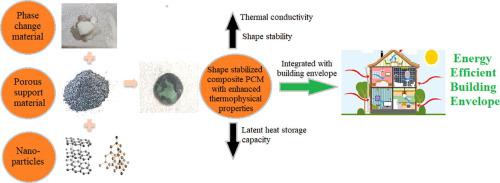Energy and Buildings ( IF 6.6 ) Pub Date : 2021-02-03 , DOI: 10.1016/j.enbuild.2021.110799 Pushpendra Kumar Singh Rathore , Shailendra Kumar Shukla

|
Thermal energy storage using organic Phase Change Material (PCM) can play an important role in effective thermal management of the building. Organic PCM are widely utilized to regulate the indoor thermal environment of the building because of good chemical and thermal stability, high heat of fusion, and large availability in the required temperature range. However, organic phase change material suffers from problems like low thermal conductivity and leakage during phase transition which limits there applicability in buildings. Therefore, the appropriate approach of preparing Shape Stabilized Composite Phase Change Material (ss-CPCM) with high thermal conductivity and no leakage will significantly improve the thermo-physical properties and increases the applicability of the organic PCM in buildings. This review is an attempt to investigate the effectiveness of organic PCM as ss-CPCM with a specific focus on its applicability in regulating the indoor thermal behavior of the buildings. It discusses in brief about thermal energy storage in buildings, PCM with emphasis on organic PCM, and shape stabilized PCM. In details, it analyzes various porous support materials and their effect on thermo-physical properties of organic PCM. Additionally, a detailed investigation of various types of nanoparticles used to enhance the thermo-physical characteristics of ss-CPCM was conducted. The study suggests that ss-CPCM has the potential to improve the thermal conductivity, minimize the leakage, and effectively regulate the indoor temperature by reducing the peak temperature and increasing the time delay. However, reduction in heat storage capacity of ss-CPCM needs to be critically analyzed. Additionally, factors like real time studies in buildings, annual/seasonal analysis, heat management from ss-CPCM during night, and techno-economic analysis of using ss-CPCM in building envelope need to be addressed.
中文翻译:

通过形状稳定化增强有机PCM的热物理性质,用于建筑物中的热能存储:最新技术回顾
使用有机相变材料(PCM)进行的热能存储可以在建筑物的有效热管理中发挥重要作用。由于良好的化学和热稳定性,高熔化热以及在所需温度范围内的可用性高,有机PCM被广泛用于调节建筑物的室内热环境。然而,有机相变材料遭受诸如低热导率和在相变期间泄漏的问题,这限制了建筑物在此的适用性。因此,制备具有高导热率且无泄漏的形状稳定的复合相变材料(ss-CPCM)的适当方法将显着改善热物理性质,并提高有机PCM在建筑物中的适用性。本文旨在研究有机PCM作为ss-CPCM的有效性,并特别关注其在调节建筑物室内热行为方面的适用性。它简要讨论了建筑物中的热能存储,强调有机PCM的PCM和形状稳定的PCM。详细地,它分析了各种多孔载体材料及其对有机PCM的热物理性质的影响。另外,对用于增强ss-CPCM的热物理特性的各种类型的纳米颗粒进行了详细研究。研究表明,ss-CPCM有潜力通过降低峰值温度和增加时间延迟来提高导热系数,最小化泄漏并有效调节室内温度。然而,ss-CPCM的储热能力下降需要进行严格分析。此外,还需要解决诸如建筑物中的实时研究,年度/季节分析,夜间通过ss-CPCM进行热量管理以及在建筑物围护结构中使用ss-CPCM的技术经济分析等因素。











































 京公网安备 11010802027423号
京公网安备 11010802027423号